Abstract
The evidence that asthma is increasing in prevalence is becoming increasingly compelling. This trend has been demonstrated not only in the United States, but also in the United Kingdom, New Zealand, Australia, and several other Western countries. In the United States, the increase is largest in the group under 18 years of age. There is mounting evidence that certain environmental air pollutants are involved in exacerbating asthma. This is based primarily on epidemiologic studies and more recent clinical studies. The U.S. Clean Air Act of 1970 provides special consideration to the class of outdoor air pollutants referred to as criteria pollutants, including O3, sulfur dioxide (SO2), particulate matter (PM), NOx, CO, and Pb. Standards for these pollutants are set by the U.S. Environmental Protection Agency with particular concern for populations at risk. Current evidence suggests that asthmatics are more sensitive to the effects of O3, SO2, PM, and NO2, and are therefore at risk. High SO2 and particulate concentrations have been associated with short-term increases in morbidity and mortality in the general population during dramatic air pollution episodes in the past. Controlled exposure studies have clearly shown that asthmatics are sensitive to low levels of SO2. Exercising asthmatics exposed to SO2 develop bronchoconstriction within minutes, even at levels of 0.25 ppm. Responses are modified by air temperature, humidity, and exercise level. Recent epidemiologic studies have suggested that exposure to PM is strongly associated with morbidity and mortality in the general population and that hospital admissions for bronchitis and asthma were associated with PM10 levels. In controlled clinical studies, asthmatics appear to be no more reactive to aerosols than healthy subjects. Consequently, it is difficult to attribute the increased mortality observed in epidemiologic studies to specific effects demonstrated in controlled human studies. Epidemiologic studies of hospital admissions for asthma have implicated O3 as contributing to the exacerbation of asthma; however, most study designs could not separate the O3 effects from the concomitant effects of acid aerosols and SO2. Controlled human clinical studies have suggested that asthmatics have similar changes in spirometry and airway reactivity in response to O3 exposure compared to healthy adults. However, a possible role of O3 in worsening atopic asthma has recently been suggested in studies combining allergen challenge following exposure to O3. Attempts at identification of factors that predispose asthmatics to responsiveness to NO2 has produced inconsistent results and requires further investigation. In summary, asthmatics have been shown to be a sensitive subpopulation relative to several of the criteria pollutants. Further research linking epidemiologic, clinical, and toxicologic approaches is required to better understand and characterize the risk of exposing asthmatics to these pollutants.
Full text
PDF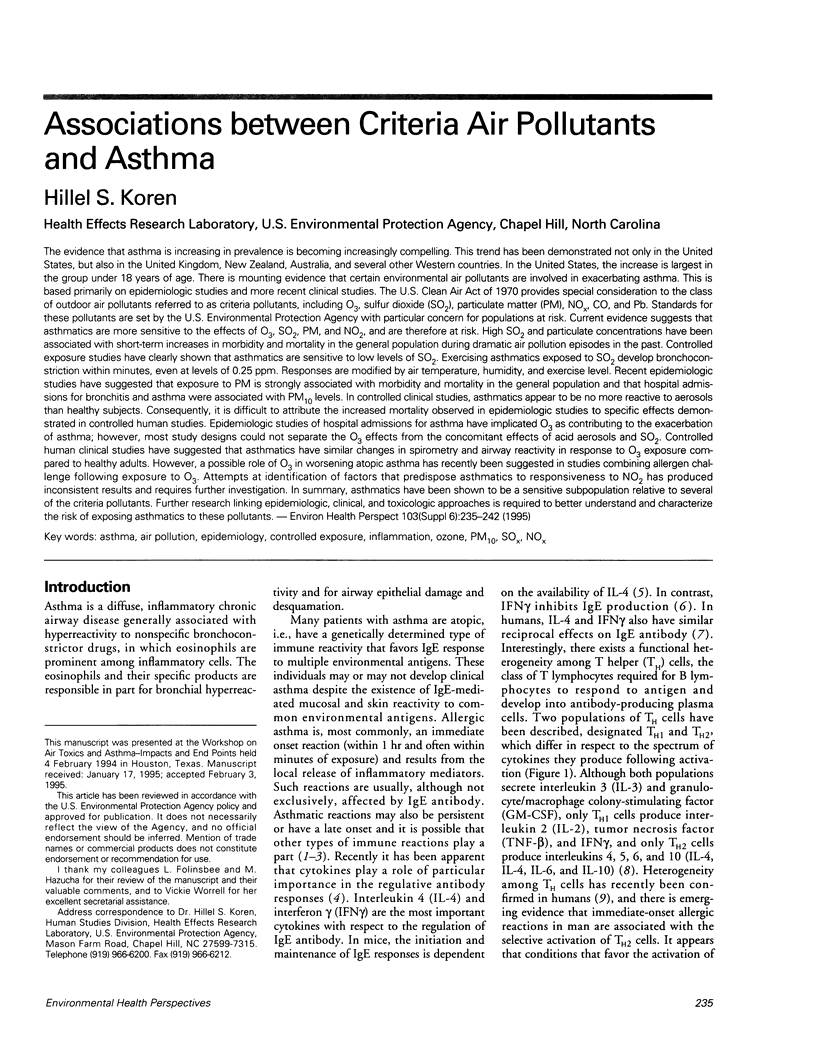
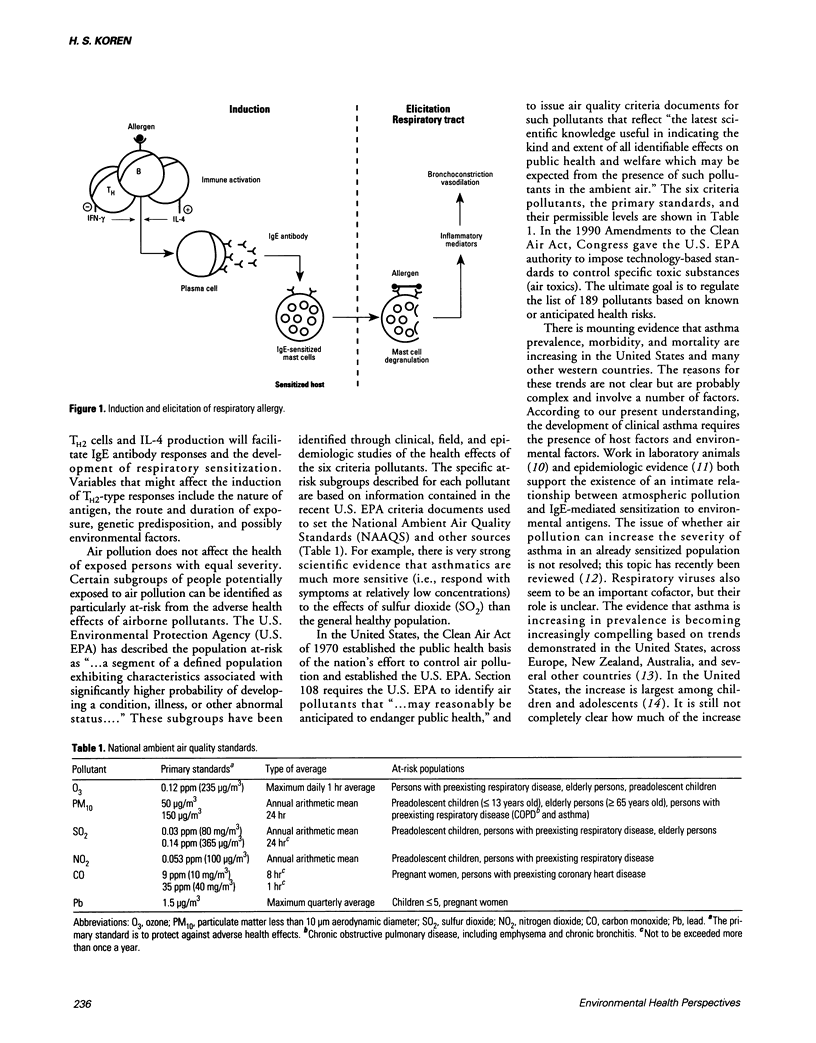
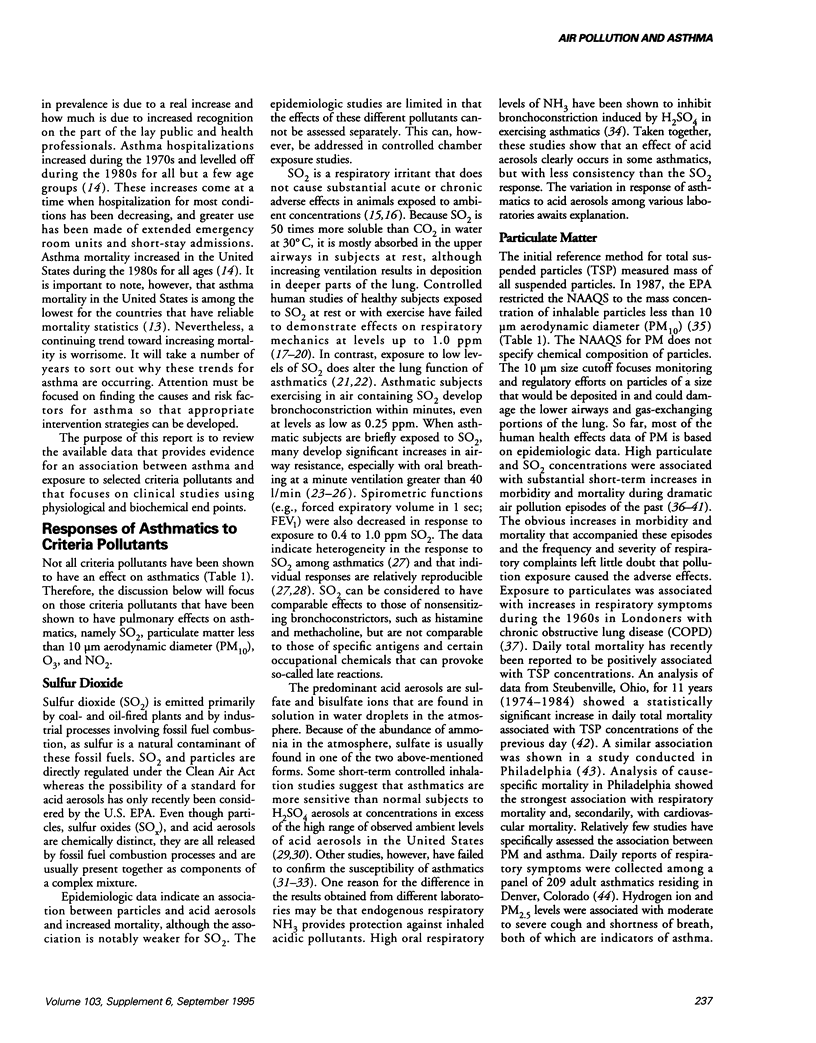
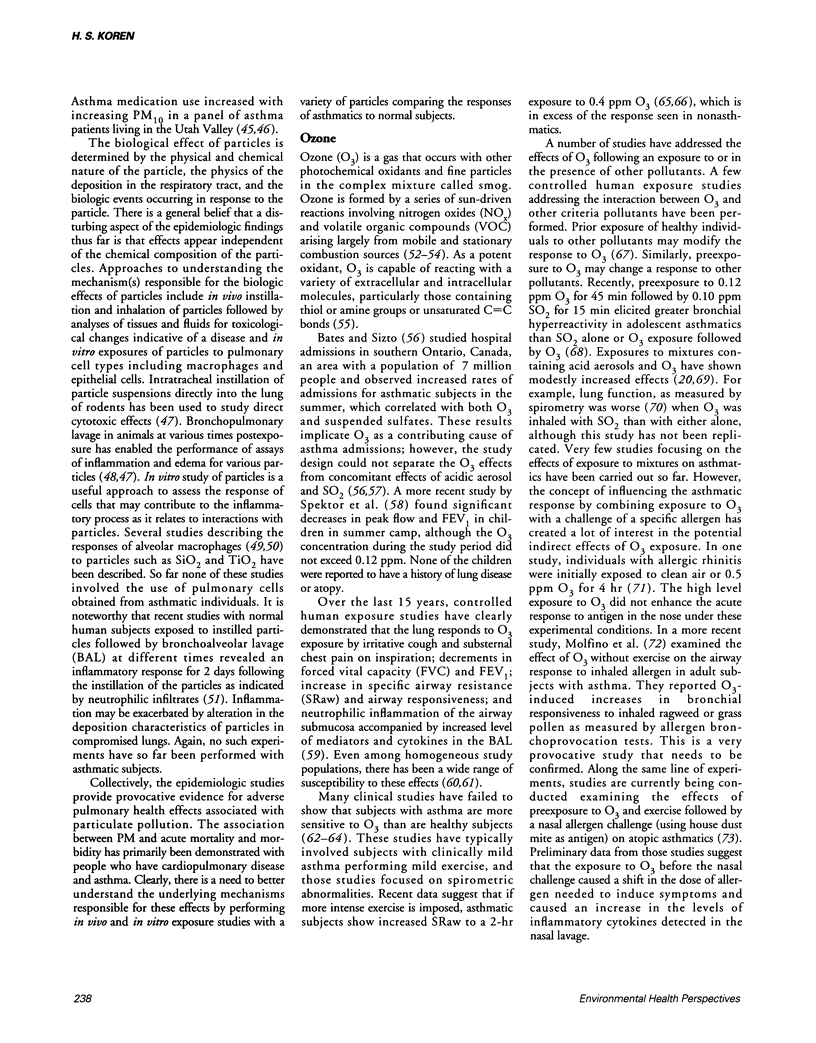

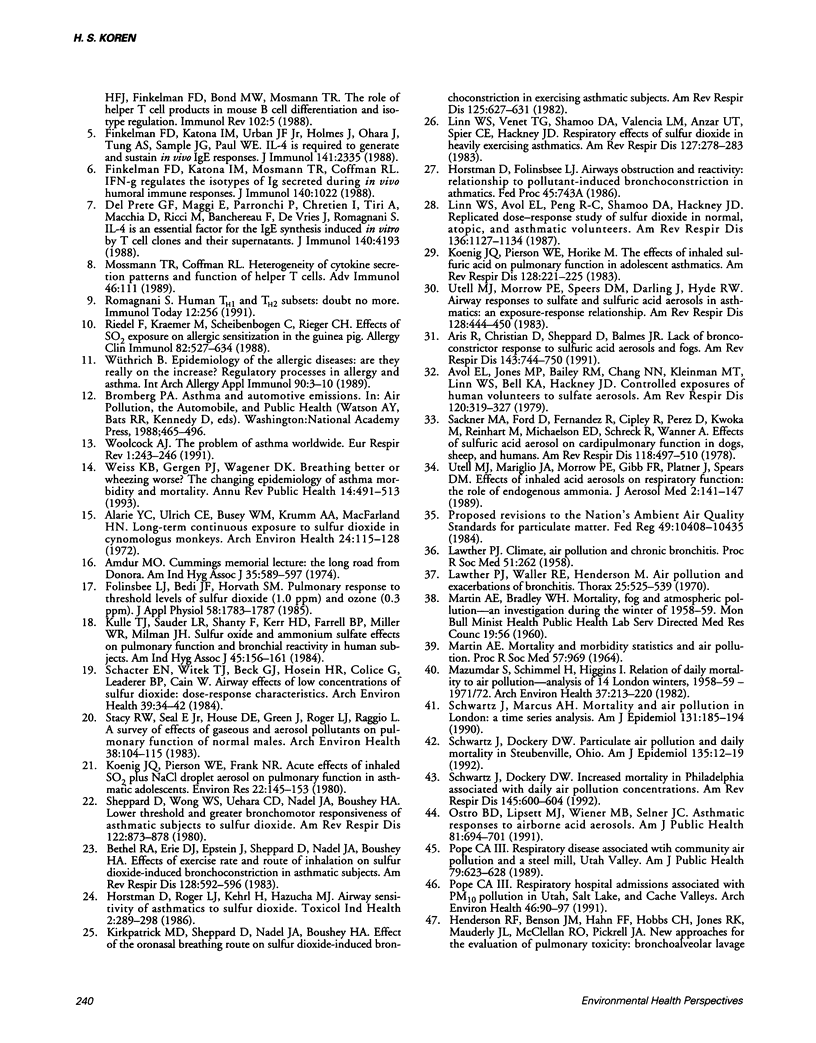
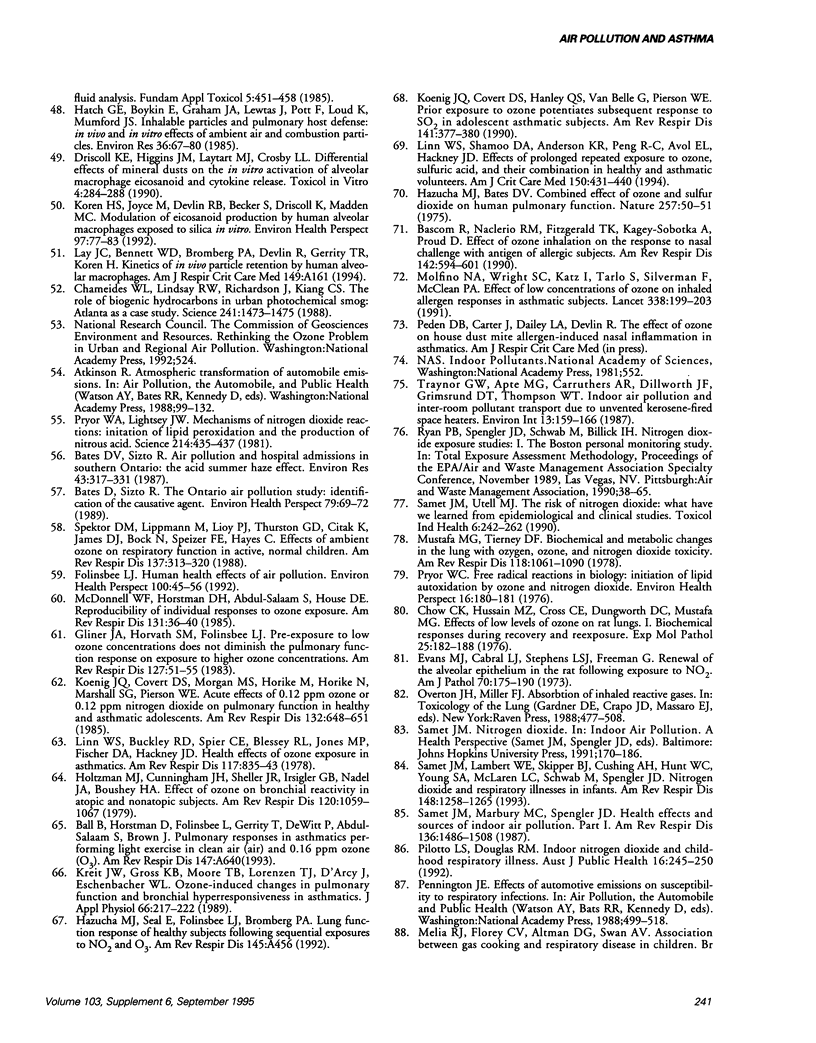
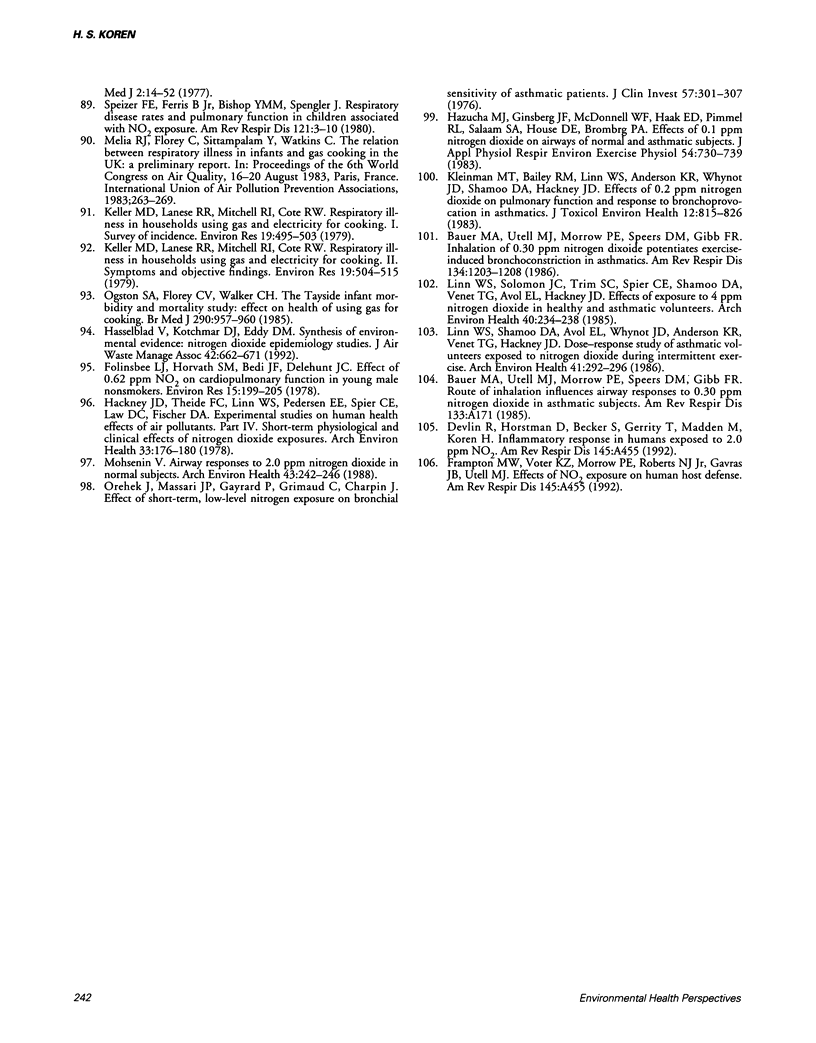
Selected References
These references are in PubMed. This may not be the complete list of references from this article.
- Alarie Y., Ulrich C. E., Busey W. M., Krumm A. A., MacFarland H. N. Long-term continuous exposure to sulfur dioxide in cynomolgus monkeys. Arch Environ Health. 1972 Feb;24(2):115–128. doi: 10.1080/00039896.1972.10666060. [DOI] [PubMed] [Google Scholar]
- Amdur M. O. 1974 Cummings Memorial Lecture. The long road from Donora. Am Ind Hyg Assoc J. 1974 Oct;35(10):589–597. doi: 10.1080/0002889748507078. [DOI] [PubMed] [Google Scholar]
- Aris R., Christian D., Sheppard D., Balmes J. R. Lack of bronchoconstrictor response to sulfuric acid aerosols and fogs. Am Rev Respir Dis. 1991 Apr;143(4 Pt 1):744–750. doi: 10.1164/ajrccm/143.4_Pt_1.744. [DOI] [PubMed] [Google Scholar]
- Avol E. L., Jones M. P., Bailey R. M., Chang N. M., Kleinman M. T., Linn W. S., Bell K. A., Hackney J. D. Controlled exposures of human volunteers to sulfate aerosols. Health effects and aerosol characterization. Am Rev Respir Dis. 1979 Aug;120(2):319–327. doi: 10.1164/arrd.1979.120.2.319. [DOI] [PubMed] [Google Scholar]
- Bascom R., Naclerio R. M., Fitzgerald T. K., Kagey-Sobotka A., Proud D. Effect of ozone inhalation on the response to nasal challenge with antigen of allergic subjects. Am Rev Respir Dis. 1990 Sep;142(3):594–601. doi: 10.1164/ajrccm/142.3.594. [DOI] [PubMed] [Google Scholar]
- Bates D. V., Sizto R. Air pollution and hospital admissions in Southern Ontario: the acid summer haze effect. Environ Res. 1987 Aug;43(2):317–331. doi: 10.1016/s0013-9351(87)80032-4. [DOI] [PubMed] [Google Scholar]
- Bates D. V., Sizto R. The Ontario Air Pollution Study: identification of the causative agent. Environ Health Perspect. 1989 Feb;79:69–72. doi: 10.1289/ehp.897969. [DOI] [PMC free article] [PubMed] [Google Scholar]
- Bauer M. A., Utell M. J., Morrow P. E., Speers D. M., Gibb F. R. Inhalation of 0.30 ppm nitrogen dioxide potentiates exercise-induced bronchospasm in asthmatics. Am Rev Respir Dis. 1986 Dec;134(6):1203–1208. doi: 10.1164/arrd.1986.134.6.1203. [DOI] [PubMed] [Google Scholar]
- Bethel R. A., Erle D. J., Epstein J., Sheppard D., Nadel J. A., Boushey H. A. Effect of exercise rate and route of inhalation on sulfur-dioxide-induced bronchoconstriction in asthmatic subjects. Am Rev Respir Dis. 1983 Oct;128(4):592–596. doi: 10.1164/arrd.1983.128.4.592. [DOI] [PubMed] [Google Scholar]
- Chameides W. L., Lindsay R. W., Richardson J., Kiang C. S. The role of biogenic hydrocarbons in urban photochemical smog: Atlanta as a case study. Science. 1988 Sep 16;241(4872):1473–1475. doi: 10.1126/science.3420404. [DOI] [PubMed] [Google Scholar]
- Chow C. K., Hussain M. Z., Cross C. E., Dungworth D. L., Mustafa M. G. Effect of low levels of ozone on rat lungs. I. Biochemical responses during recovery and reexposure. Exp Mol Pathol. 1976 Oct;25(2):182–188. doi: 10.1016/0014-4800(76)90028-9. [DOI] [PubMed] [Google Scholar]
- Del Prete G., Maggi E., Parronchi P., Chrétien I., Tiri A., Macchia D., Ricci M., Banchereau J., De Vries J., Romagnani S. IL-4 is an essential factor for the IgE synthesis induced in vitro by human T cell clones and their supernatants. J Immunol. 1988 Jun 15;140(12):4193–4198. [PubMed] [Google Scholar]
- Evans M. J., Cabral L. J., Stephens R. J., Freeman G. Renewal of alveolar epithelium in the rat following exposure to NO2. Am J Pathol. 1973 Feb;70(2):175–198. [PMC free article] [PubMed] [Google Scholar]
- Finkelman F. D., Katona I. M., Mosmann T. R., Coffman R. L. IFN-gamma regulates the isotypes of Ig secreted during in vivo humoral immune responses. J Immunol. 1988 Feb 15;140(4):1022–1027. [PubMed] [Google Scholar]
- Finkelman F. D., Katona I. M., Urban J. F., Jr, Holmes J., Ohara J., Tung A. S., Sample J. V., Paul W. E. IL-4 is required to generate and sustain in vivo IgE responses. J Immunol. 1988 Oct 1;141(7):2335–2341. [PubMed] [Google Scholar]
- Folinsbee L. J., Bedi J. F., Horvath S. M. Pulmonary response to threshold levels of sulfur dioxide (1.0 ppm) and ozone (0.3 ppm). J Appl Physiol (1985) 1985 Jun;58(6):1783–1787. doi: 10.1152/jappl.1985.58.6.1783. [DOI] [PubMed] [Google Scholar]
- Folinsbee L. J., Horvath S. M., Bedi J. F., Delehunt J. C. Effect of 0.62 ppm NO2 on cardiopulmonary function in young male nonsmokers. Environ Res. 1978 Apr;15(2):199–205. doi: 10.1016/0013-9351(78)90096-8. [DOI] [PubMed] [Google Scholar]
- Folinsbee L. J. Human health effects of air pollution. Environ Health Perspect. 1993 Apr;100:45–56. doi: 10.1289/ehp.9310045. [DOI] [PMC free article] [PubMed] [Google Scholar]
- Gliner J. A., Horvath S. M., Folinsbee L. J. Preexposure to low ozone concentrations does not diminish the pulmonary function response on exposure to higher ozone concentrations. Am Rev Respir Dis. 1983 Jan;127(1):51–55. doi: 10.1164/arrd.1983.127.1.51. [DOI] [PubMed] [Google Scholar]
- Hackney J. D., Thiede F. C., Linn W. S., Pedersen E. E., Spier C. E., Law D. C., Fischer D. A. Experimental studies on human health effects of air pollutants. IV. Short-term physiological and clinical effects of nitrogen dioxide exposure. Arch Environ Health. 1978 Jul-Aug;33(4):176–180. doi: 10.1080/00039896.1978.10667330. [DOI] [PubMed] [Google Scholar]
- Hasselblad V., Eddy D. M., Kotchmar D. J. Synthesis of environmental evidence: nitrogen dioxide epidemiology studies. J Air Waste Manage Assoc. 1992 May;42(5):662–671. doi: 10.1080/10473289.1992.10467018. [DOI] [PubMed] [Google Scholar]
- Hatch G. E., Boykin E., Graham J. A., Lewtas J., Pott F., Loud K., Mumford J. L. Inhalable particles and pulmonary host defense: in vivo and in vitro effects of ambient air and combustion particles. Environ Res. 1985 Feb;36(1):67–80. doi: 10.1016/0013-9351(85)90008-8. [DOI] [PubMed] [Google Scholar]
- Hazucha M. J., Ginsberg J. F., McDonnell W. F., Haak E. D., Jr, Pimmel R. L., Salaam S. A., House D. E., Bromberg P. A. Effects of 0.1 ppm nitrogen dioxide on airways of normal and asthmatic subjects. J Appl Physiol Respir Environ Exerc Physiol. 1983 Mar;54(3):730–739. doi: 10.1152/jappl.1983.54.3.730. [DOI] [PubMed] [Google Scholar]
- Hazucha M., Bates D. V. Combined effect of ozone and sulphur dioxide on human pulmonary function. Nature. 1975 Sep 4;257(5521):50–51. doi: 10.1038/257050a0. [DOI] [PubMed] [Google Scholar]
- Henderson R. F., Benson J. M., Hahn F. F., Hobbs C. H., Jones R. K., Mauderly J. L., McClellan R. O., Pickrell J. A. New approaches for the evaluation of pulmonary toxicity: bronchoalveolar lavage fluid analysis. Fundam Appl Toxicol. 1985 Jun;5(3):451–458. doi: 10.1016/0272-0590(85)90092-2. [DOI] [PubMed] [Google Scholar]
- Holtzman M. J., Cunningham J. H., Sheller J. R., Irsigler G. B., Nadel J. A., Boushey H. A. Effect of ozone on bronchial reactivity in atopic and nonatopic subjects. Am Rev Respir Dis. 1979 Nov;120(5):1059–1067. doi: 10.1164/arrd.1979.120.5.1059. [DOI] [PubMed] [Google Scholar]
- Horstman D., Roger L. J., Kehrl H., Hazucha M. Airway sensitivity of asthmatics to sulfur dioxide. Toxicol Ind Health. 1986 Sep;2(3):289–298. doi: 10.1177/074823378600200307. [DOI] [PubMed] [Google Scholar]
- Keller M. D., Lanese R. R., Mitchell R. I., Cote R. W. Respiratory illness in households using gas and electricity for cooking. I. Survey of incidence. Environ Res. 1979 Aug;19(2):495–503. doi: 10.1016/0013-9351(79)90073-2. [DOI] [PubMed] [Google Scholar]
- Keller M. D., Lanese R. R., Mitchell R. I., Cote R. W. Respiratory illness in households using gas and electricity for cooking. II. Symptoms and objective findings. Environ Res. 1979 Aug;19(2):504–515. doi: 10.1016/0013-9351(79)90074-4. [DOI] [PubMed] [Google Scholar]
- Kirkpatrick M. B., Sheppard D., Nadel J. A., Boushey H. A. Effect of the oronasal breathing route on sulfur dioxide-induced bronchoconstriction in exercising asthmatic subjects. Am Rev Respir Dis. 1982 Jun;125(6):627–631. doi: 10.1164/arrd.1982.125.6.627. [DOI] [PubMed] [Google Scholar]
- Kleinman M. T., Bailey R. M., Linn W. S., Anderson K. R., Whynot J. D., Shamoo D. A., Hackney J. D. Effects of 0.2 ppm nitrogen dioxide on pulmonary function and response to bronchoprovocation in asthmatics. J Toxicol Environ Health. 1983 Oct-Dec;12(4-6):815–826. doi: 10.1080/15287398309530472. [DOI] [PubMed] [Google Scholar]
- Koenig J. Q., Covert D. S., Hanley Q. S., van Belle G., Pierson W. E. Prior exposure to ozone potentiates subsequent response to sulfur dioxide in adolescent asthmatic subjects. Am Rev Respir Dis. 1990 Feb;141(2):377–380. doi: 10.1164/ajrccm/141.2.377. [DOI] [PubMed] [Google Scholar]
- Koenig J. Q., Covert D. S., Morgan M. S., Horike M., Horike N., Marshall S. G., Pierson W. E. Acute effects of 0.12 ppm ozone or 0.12 ppm nitrogen dioxide on pulmonary function in healthy and asthmatic adolescents. Am Rev Respir Dis. 1985 Sep;132(3):648–651. doi: 10.1164/arrd.1985.132.3.648. [DOI] [PubMed] [Google Scholar]
- Koenig J. Q., Pierson W. E., Frank R. Acute effects of inhaled SO2 plus NaCl droplet aerosol on pulmonary function in asthmatic adolescents. Environ Res. 1980 Jun;22(1):145–153. doi: 10.1016/0013-9351(80)90126-7. [DOI] [PubMed] [Google Scholar]
- Koenig J. Q., Pierson W. E., Horike M. The effects of inhaled sulfuric acid on pulmonary function in adolescent asthmatics. Am Rev Respir Dis. 1983 Aug;128(2):221–225. doi: 10.1164/arrd.1983.128.2.221. [DOI] [PubMed] [Google Scholar]
- Koren H. S., Joyce M., Devlin R. B., Becker S., Driscoll K., Madden M. C. Modulation of eicosanoid production by human alveolar macrophages exposed to silica in vitro. Environ Health Perspect. 1992 Jul;97:77–83. doi: 10.1289/ehp.929777. [DOI] [PMC free article] [PubMed] [Google Scholar]
- Kreit J. W., Gross K. B., Moore T. B., Lorenzen T. J., D'Arcy J., Eschenbacher W. L. Ozone-induced changes in pulmonary function and bronchial responsiveness in asthmatics. J Appl Physiol (1985) 1989 Jan;66(1):217–222. doi: 10.1152/jappl.1989.66.1.217. [DOI] [PubMed] [Google Scholar]
- Kulle T. J., Sauder L. R., Shanty F., Kerr H. D., Farrell B. P., Miller W. R., Milman J. H. Sulfur dioxide and ammonium sulfate effects on pulmonary function and bronchial reactivity in human subjects. Am Ind Hyg Assoc J. 1984 Mar;45(3):156–161. doi: 10.1080/15298668491399569. [DOI] [PubMed] [Google Scholar]
- LAWTHER P. J. Climate, air pollution and chronic bronchitis. Proc R Soc Med. 1958 Apr;51(4):262–264. [PubMed] [Google Scholar]
- Lawther P. J., Waller R. E., Henderson M. Air pollution and exacerbations of bronchitis. Thorax. 1970 Sep;25(5):525–539. doi: 10.1136/thx.25.5.525. [DOI] [PMC free article] [PubMed] [Google Scholar]
- Linn W. S., Avol E. L., Peng R. C., Shamoo D. A., Hackney J. D. Replicated dose-response study of sulfur dioxide effects in normal, atopic, and asthmatic volunteers. Am Rev Respir Dis. 1987 Nov;136(5):1127–1134. doi: 10.1164/ajrccm/136.5.1127. [DOI] [PubMed] [Google Scholar]
- Linn W. S., Buckley R. D., Spier C. E., Blessey R. L., Jones M. P., Fischer D. A., Hackney J. D. Health effects of ozone exposure in asthmatics. Am Rev Respir Dis. 1978 May;117(5):835–843. doi: 10.1164/arrd.1978.117.5.835. [DOI] [PubMed] [Google Scholar]
- Linn W. S., Shamoo D. A., Anderson K. R., Peng R. C., Avol E. L., Hackney J. D. Effects of prolonged, repeated exposure to ozone, sulfuric acid, and their combination in healthy and asthmatic volunteers. Am J Respir Crit Care Med. 1994 Aug;150(2):431–440. doi: 10.1164/ajrccm.150.2.8049826. [DOI] [PubMed] [Google Scholar]
- Linn W. S., Shamoo D. A., Avol E. L., Whynot J. D., Anderson K. R., Venet T. G., Hackney J. D. Dose-response study of asthmatic volunteers exposed to nitrogen dioxide during intermittent exercise. Arch Environ Health. 1986 Sep-Oct;41(5):292–296. doi: 10.1080/00039896.1986.9936699. [DOI] [PubMed] [Google Scholar]
- Linn W. S., Solomon J. C., Trim S. C., Spier C. E., Shamoo D. A., Venet T. G., Avol E. L., Hackney J. D. Effects of exposure to 4 ppm nitrogen dioxide in healthy and asthmatic volunteers. Arch Environ Health. 1985 Jul-Aug;40(4):234–239. doi: 10.1080/00039896.1985.10545925. [DOI] [PubMed] [Google Scholar]
- Linn W. S., Venet T. G., Shamoo D. A., Valencia L. M., Anzar U. T., Spier C. E., Hackney J. D. Respiratory effects of sulfur dioxide in heavily exercising asthmatics. A dose-response study. Am Rev Respir Dis. 1983 Mar;127(3):278–283. doi: 10.1164/arrd.1983.127.3.278. [DOI] [PubMed] [Google Scholar]
- MARTIN A. E., BRADLEY W. H. Mortality, fog and atmospheric pollution: an investigation during the winter of 1958-59. Mon Bull Minist Health Public Health Lab Serv. 1960 May;19:56–72. [PubMed] [Google Scholar]
- MARTIN A. E. MORTALITY AND MORBIDITY STATISTICS AND AIR POLLUTION. Proc R Soc Med. 1964 Oct;57:SUPPL–SUPPL:975. doi: 10.1177/003591576405710P202. [DOI] [PMC free article] [PubMed] [Google Scholar]
- Mazumdar S., Schimmel H., Higgins I. T. Relation of daily mortality to air pollution: an analysis of 14 London winters, 1958/59-1971/72. Arch Environ Health. 1982 Jul-Aug;37(4):213–220. doi: 10.1080/00039896.1982.10667567. [DOI] [PubMed] [Google Scholar]
- McDonnell W. F., 3rd, Horstman D. H., Abdul-Salaam S., House D. E. Reproducibility of individual responses to ozone exposure. Am Rev Respir Dis. 1985 Jan;131(1):36–40. doi: 10.1164/arrd.1985.131.S5.S36. [DOI] [PubMed] [Google Scholar]
- Mohsenin V. Airway responses to 2.0 ppm nitrogen dioxide in normal subjects. Arch Environ Health. 1988 May-Jun;43(3):242–246. doi: 10.1080/00039896.1988.9934941. [DOI] [PubMed] [Google Scholar]
- Molfino N. A., Wright S. C., Katz I., Tarlo S., Silverman F., McClean P. A., Szalai J. P., Raizenne M., Slutsky A. S., Zamel N. Effect of low concentrations of ozone on inhaled allergen responses in asthmatic subjects. Lancet. 1991 Jul 27;338(8761):199–203. doi: 10.1016/0140-6736(91)90346-q. [DOI] [PubMed] [Google Scholar]
- Mosmann T. R., Coffman R. L. Heterogeneity of cytokine secretion patterns and functions of helper T cells. Adv Immunol. 1989;46:111–147. doi: 10.1016/s0065-2776(08)60652-5. [DOI] [PubMed] [Google Scholar]
- Mustafa M. G., Tierney D. F. Biochemical and metabolic changes in the lung with oxygen, ozone, and nitrogen dioxide toxicity. Am Rev Respir Dis. 1978 Dec;118(6):1061–1090. doi: 10.1164/arrd.1978.118.6.1061. [DOI] [PubMed] [Google Scholar]
- Ogston S. A., Florey C. D., Walker C. H. The Tayside infant morbidity and mortality study: effect on health of using gas for cooking. Br Med J (Clin Res Ed) 1985 Mar 30;290(6473):957–960. doi: 10.1136/bmj.290.6473.957. [DOI] [PMC free article] [PubMed] [Google Scholar]
- Orehek J., Massari J. P., Gayrard P., Grimaud C., Charpin J. Effect of short-term, low-level nitrogen dioxide exposure on bronchial sensitivity of asthmatic patients. J Clin Invest. 1976 Feb;57(2):301–307. doi: 10.1172/JCI108281. [DOI] [PMC free article] [PubMed] [Google Scholar]
- Ostro B. D., Lipsett M. J., Wiener M. B., Selner J. C. Asthmatic responses to airborne acid aerosols. Am J Public Health. 1991 Jun;81(6):694–702. doi: 10.2105/ajph.81.6.694. [DOI] [PMC free article] [PubMed] [Google Scholar]
- Pilotto L. S., Douglas R. M. Indoor nitrogen dioxide and childhood respiratory illness. Aust J Public Health. 1992 Sep;16(3):245–250. doi: 10.1111/j.1753-6405.1992.tb00062.x. [DOI] [PubMed] [Google Scholar]
- Pope C. A., 3rd Respiratory disease associated with community air pollution and a steel mill, Utah Valley. Am J Public Health. 1989 May;79(5):623–628. doi: 10.2105/ajph.79.5.623. [DOI] [PMC free article] [PubMed] [Google Scholar]
- Pope C. A., 3rd Respiratory hospital admissions associated with PM10 pollution in Utah, Salt Lake, and Cache Valleys. Arch Environ Health. 1991 Mar-Apr;46(2):90–97. doi: 10.1080/00039896.1991.9937434. [DOI] [PubMed] [Google Scholar]
- Pryor W. A., Lightsey J. W. Mechanisms of nitrogen dioxide reactions: initiation of lipid peroxidation and the production of nitrous Acid. Science. 1981 Oct 23;214(4519):435–437. doi: 10.1126/science.214.4519.435. [DOI] [PubMed] [Google Scholar]
- Riedel F., Krämer M., Scheibenbogen C., Rieger C. H. Effects of SO2 exposure on allergic sensitization in the guinea pig. J Allergy Clin Immunol. 1988 Oct;82(4):527–534. doi: 10.1016/0091-6749(88)90961-x. [DOI] [PubMed] [Google Scholar]
- Romagnani S. Human TH1 and TH2 subsets: doubt no more. Immunol Today. 1991 Aug;12(8):256–257. doi: 10.1016/0167-5699(91)90120-I. [DOI] [PubMed] [Google Scholar]
- Sackner M. A., Ford D., Fernandez R., Cipley J., Perez D., Kwoka M., Reinhart M., Michaelson E. D., Schreck R., Wanner A. Effects of sulfuric acid aerosol on cardiopulmonary function of dogs, sheep, and humans. Am Rev Respir Dis. 1978 Sep;118(3):497–510. doi: 10.1164/arrd.1978.118.3.497. [DOI] [PubMed] [Google Scholar]
- Samet J. M., Lambert W. E., Skipper B. J., Cushing A. H., Hunt W. C., Young S. A., McLaren L. C., Schwab M., Spengler J. D. Nitrogen dioxide and respiratory illnesses in infants. Am Rev Respir Dis. 1993 Nov;148(5):1258–1265. doi: 10.1164/ajrccm/148.5.1258. [DOI] [PubMed] [Google Scholar]
- Samet J. M., Marbury M. C., Spengler J. D. Health effects and sources of indoor air pollution. Part I. Am Rev Respir Dis. 1987 Dec;136(6):1486–1508. doi: 10.1164/ajrccm/136.6.1486. [DOI] [PubMed] [Google Scholar]
- Samet J. M., Utell M. J. The risk of nitrogen dioxide: what have we learned from epidemiological and clinical studies? Toxicol Ind Health. 1990 Mar;6(2):247–262. [PubMed] [Google Scholar]
- Schachter E. N., Witek T. J., Jr, Beck G. J., Hosein H. B., Colice G., Leaderer B. P., Cain W. Airway effects of low concentrations of sulfur dioxide: dose-response characteristics. Arch Environ Health. 1984 Jan-Feb;39(1):34–42. doi: 10.1080/00039896.1984.10545831. [DOI] [PubMed] [Google Scholar]
- Schwartz J., Dockery D. W. Increased mortality in Philadelphia associated with daily air pollution concentrations. Am Rev Respir Dis. 1992 Mar;145(3):600–604. doi: 10.1164/ajrccm/145.3.600. [DOI] [PubMed] [Google Scholar]
- Schwartz J., Dockery D. W. Particulate air pollution and daily mortality in Steubenville, Ohio. Am J Epidemiol. 1992 Jan 1;135(1):12–25. doi: 10.1093/oxfordjournals.aje.a116195. [DOI] [PubMed] [Google Scholar]
- Schwartz J., Marcus A. Mortality and air pollution in London: a time series analysis. Am J Epidemiol. 1990 Jan;131(1):185–194. doi: 10.1093/oxfordjournals.aje.a115473. [DOI] [PubMed] [Google Scholar]
- Sheppard D., Wong W. S., Uehara C. F., Nadel J. A., Boushey H. A. Lower threshold and greater bronchomotor responsiveness of asthmatic subjects to sulfur dioxide. Am Rev Respir Dis. 1980 Dec;122(6):873–878. doi: 10.1164/arrd.1980.122.6.873. [DOI] [PubMed] [Google Scholar]
- Speizer F. E., Ferris B., Jr, Bishop Y. M., Spengler J. Respiratory disease rates and pulmonary function in children associated with NO2 exposure. Am Rev Respir Dis. 1980 Jan;121(1):3–10. doi: 10.1164/arrd.1980.121.1.3. [DOI] [PubMed] [Google Scholar]
- Spektor D. M., Lippmann M., Lioy P. J., Thurston G. D., Citak K., James D. J., Bock N., Speizer F. E., Hayes C. Effects of ambient ozone on respiratory function in active, normal children. Am Rev Respir Dis. 1988 Feb;137(2):313–320. doi: 10.1164/ajrccm/137.2.313. [DOI] [PubMed] [Google Scholar]
- Stacy R. W., Seal E., Jr, House D. E., Green J., Roger L. J., Raggio L. A survey of effects of gaseous and aerosol pollutants on pulmonary function of normal males. Arch Environ Health. 1983 Mar-Apr;38(2):104–115. doi: 10.1080/00039896.1983.10543989. [DOI] [PubMed] [Google Scholar]
- Utell M. J., Morrow P. E., Speers D. M., Darling J., Hyde R. W. Airway responses to sulfate and sulfuric acid aerosols in asthmatics. An exposure-response relationship. Am Rev Respir Dis. 1983 Sep;128(3):444–450. doi: 10.1164/arrd.1983.128.3.444. [DOI] [PubMed] [Google Scholar]
- Weiss K. B., Gergen P. J., Wagener D. K. Breathing better or wheezing worse? The changing epidemiology of asthma morbidity and mortality. Annu Rev Public Health. 1993;14:491–513. doi: 10.1146/annurev.pu.14.050193.002423. [DOI] [PubMed] [Google Scholar]
- Wüthrich B. Epidemiology of the allergic diseases: are they really on the increase? Int Arch Allergy Appl Immunol. 1989;90 (Suppl 1):3–10. doi: 10.1159/000235067. [DOI] [PubMed] [Google Scholar]


